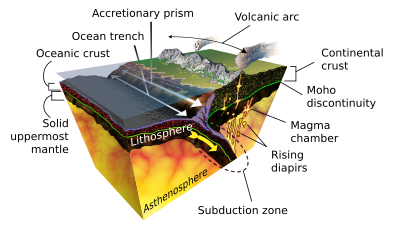
Back Oseaantrog Afrikaans خندق محيطي Arabic Fuexa oceánica AST Глыбакаводны жолаб Byelorussian Океанска падина Bulgarian সমুদ্র খাত Bengali/Bangla Foz danvorel Breton Fossa marina Catalan Hlubokomořský příkop Czech Oceangrav Danish

Oceanic trenches are prominent, long, narrow topographic depressions of the ocean floor. They are typically 50 to 100 kilometers (30 to 60 mi) wide and 3 to 4 km (1.9 to 2.5 mi) below the level of the surrounding oceanic floor, but can be thousands of kilometers in length. There are about 50,000 km (31,000 mi) of oceanic trenches worldwide, mostly around the Pacific Ocean, but also in the eastern Indian Ocean and a few other locations. The greatest ocean depth measured is in the Challenger Deep of the Mariana Trench, at a depth of 10,994 m (36,070 ft) below sea level.
Oceanic trenches are a feature of the Earth's distinctive plate tectonics. They mark the locations of convergent plate boundaries, along which lithospheric plates move towards each other at rates that vary from a few millimeters to over ten centimeters per year. Oceanic lithosphere moves into trenches at a global rate of about 3 km2 (1.2 sq mi) per year.[1] A trench marks the position at which the flexed, subducting slab begins to descend beneath another lithospheric slab. Trenches are generally parallel to and about 200 km (120 mi) from a volcanic arc.
Much of the fluid trapped in sediments of the subducting slab returns to the surface at the oceanic trench, producing mud volcanoes and cold seeps. These support unique biomes based on chemotrophic microorganisms. There is concern that plastic debris is accumulating in trenches and threatening these communities.
© MMXXIII Rich X Search. We shall prevail. All rights reserved. Rich X Search